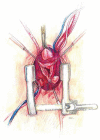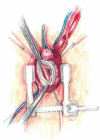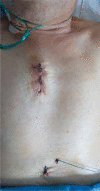Mini-David procedure. Procedural considerations
- PMID: 36643346
- PMCID: PMC9809191
- DOI: 10.5114/kitp.2022.122096
Mini-David procedure. Procedural considerations
Abstract
The main goal of minimally invasive surgery is to reduce the perioperative trauma, accelerate patient mobilization and reduce the length of hospital stay. Due to the development of modern technology, these treatments can be offered to a wider group of patients. For many years, aortic root surgery consisted of mechanical conduit implantation and, therefore, necessitated life-long anticoagulation. At present, in patients with aortic root aneurysm and significant aortic valve regurgitation, it is possible to perform minimal-access valve sparing surgical procedures. The current paper is a brief description of the surgical technique for aortic root aneurysm surgery with preservation of the patient's own valve using the David procedure.
Keywords: David procedure; V-shape ministernotomy; VSSR; minimally invasive surgery.
Copyright: © 2022 Polish Society of Cardiothoracic Surgeons (Polskie Towarzystwo KardioTorakochirurgów) and the editors of the Polish Journal of Cardio-Thoracic Surgery (Kardiochirurgia i Torakochirurgia Polska).
Conflict of interest statement
The authors report no conflict of interest.
Figures









References
-
- Chaer RA, Vasoncelos R, Marone LK, Al-Khoury G, Rhee RY, Cho JS, Makaroun MS. Synchronous and metachronous thoracic aneurysms in patients with abdominalaortic aneurysms. J Vasc Surg 2012; 56: 1261-1265. - PubMed
-
- Schaefer BM, Lewin MB, Stout KK, Gill E, Prueitt A, Byers PH, Otto CM. The bicuspidaortic valve: an integrated phenotypic classification of leaflet morphology and aorticroot shape. Heart 2008; 94: 1634-1638. - PubMed
-
- David TE, Feindel CM, Webb GD, Colman JM, Armstrong S, Maganti M. Long-term results of aortic valve-sparing operations for aortic root aneurysm. J Thorac Cardiovasc Surg 2006; 132: 347-354. - PubMed
LinkOut - more resources
Full Text Sources
